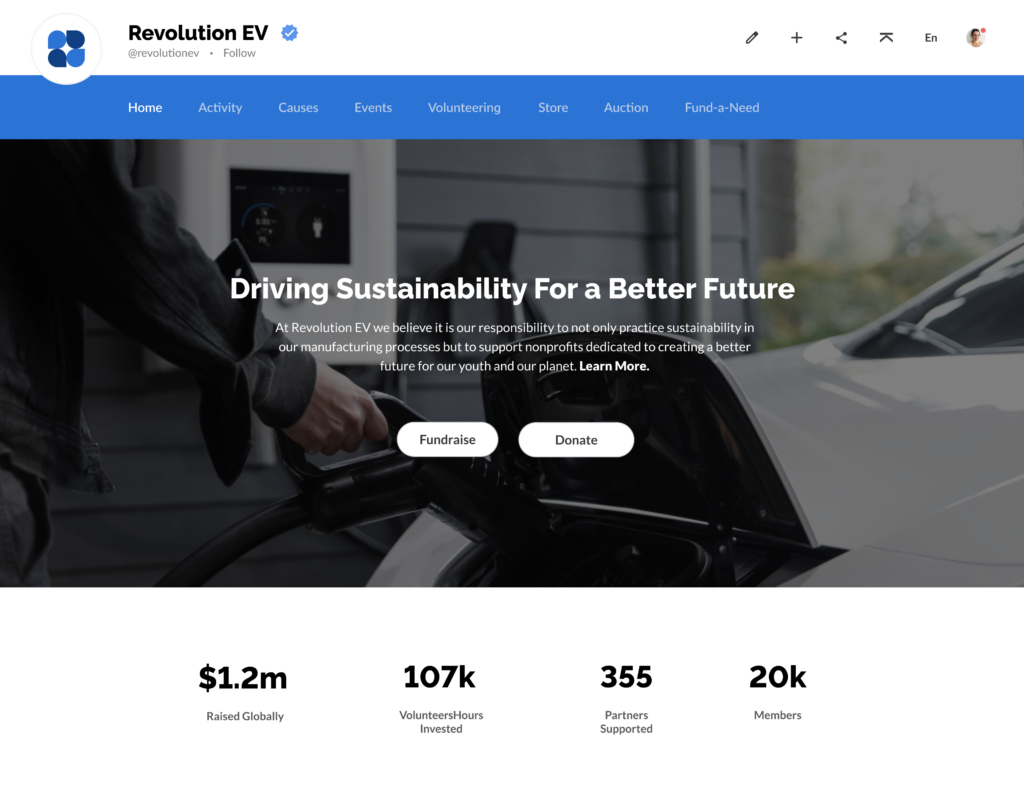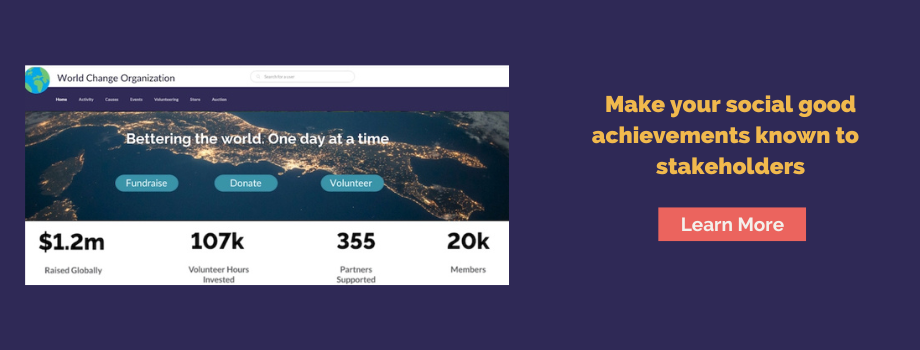Whether you’re announcing news of an upcoming acquisition, a recent product launch, or the acceptance of an award, these posts you are sharing with your network are likely to draw attention and spark a conversation. A key type of post that is often overlooked but equally valuable to share is your organization’s social impact.
Social impact refers to the effects your social good efforts have on the local community and the global environment. For example, a CSR initiative would be implementing a corporate giving program that connects your employees with local nonprofits.
When sharing the results of this CSR initiative, your business could showcase a few metrics: total employee volunteers, hours of service, and the number of charitable causes supported—this is otherwise known as your organization’s social impact. These results are what convey meaning and validity beyond what can be expressed in words.
Just as companies are quick to announce a new client or sales growth, sharing your organization’s social impact is worth communicating to display transparency and accountability. We uncover a few top reasons why sharing this story is the most important one to tell.
Kambeo Hubs: A place to create, share, and grow your social impact

By sharing your achievements on Kambeo Hubs, you will be able to reflect on these positive experiences, discover new approaches to achieve social good, and inspire others to create the change they want to see.
Benefits Of Sharing Your Organization’s Social Impact
Increase awareness
With each social impact post, whether that be distributed on your website, social media channels, or a press release, comes an opportunity to build familiarity with new consumers—letting them know your brand exists.
Sharing your organization’s commitment to social and environmental issues, as well as the impact your actions have had, is one of the best ways to build a memorable first impression and get consumers to remember your brand.
As 40% of consumers are looking to find purpose-driven brands, companies that measure, evaluate, and share their social good stories will not only garner attention from these value-aligned consumers but will also gain support from them.
Build brand equity
When consumers are deciding between Brand A (which is more expensive) and Brand B, several factors go through their minds. Of course, we might automatically think that the cheaper option will always lead to a purchase, but this isn’t always the case.
A study by Unilever concluded that 33% (one-third) of consumers now choose to buy from companies that are doing social or environmental good. This finding is because brand equity plays a role in the decision-making process.
Brand equity refers to why a consumer chooses one brand over another. For instance, a small tech company could share how it’s making a difference in the world and its achievements to date. In turn, its consumers will begin to associate the small tech company with positive attributes, and when it comes time to make a new or repeat purchase, these elements will influence a consumer’s final decision.
Diversify your content
Consumers are 4 to 6 times more likely to purchase from a purpose-driven company. How do they assess whether a company is purpose-driven and not operating solely for profit? Through reading content posted by an organization. By incorporating your company’s social impact into your content lineup and sharing it regularly, your consumers will instantly understand how you are devoted to enriching others’ lives.
An easy tip for ensuring what you share is multi-faceted is to find a balance between these three areas:
- Discuss the core features of your product/service.
- Communicate how your offering is the solution to your consumer’s problems.
- Share what you are doing for the greater good of society.
Demonstrate your values
Values are the guiding principles of your business. There are many ways organizations can communicate their values, ranging from an internal code of conduct to speaking engagements. However, one of the most effective ways to prove that what you are saying has validity is through sharing your social impact.
Telus, a Canadian National telecommunications company, communicates its values on its website. One of its values states, “We passionately put our customers and communities first.” Even though Telus’ value statement is clear and specific, there is no proof to support its position as a community changemaker.
Enter its social impact landing page, which is focused on sharing and measuring all of the great work that Telus is doing. Telus hosts an ‘Annual Telus Days of Giving,’ bringing together team members and community supporters to make a positive impact on local communities. For maximum credibility, Telus shares stories of how its team members have given back and the results derived from these efforts.

Inspire other changemakers
Regardless of who a changemaker is, they are all eager to take initiative and are driven by passion. Organizations can do their part to push these changemakers (who are current or prospective customers, employees, and investors) to find new charitable giving opportunities and make a greater impact by sharing their own stories.
It isn’t just about the nonprofits and charities spreading the word about their cause and encouraging others to stand with them; businesses can do their part to advocate change. Purpose-driven companies who understand their social impact and share it with the world can aid in inspiring a movement of others to create a better world.
As many consumers are taking a stance on social issues and wanting to leave their mark, they expect the companies they support to do the same. Sharing your organization’s social impact tells your story from beginning to end, giving your audience an in-depth view of the results you have achieved to positively impact your community.



